Tools - Middle East - Photo gallery
Image database with photographs of ancient art and antiquities
Our image database provides photographs of ancient art and antiquities for press releases as well as for private use. All artefacts sold in our gallery are documented through professional photographs. The resulting image library contains numerous ancient Egyptian, Greek and Roman antiquities as well as ancient coins. The time span from Stone Age, over Bronze Age and Classical Antiquity until Late Antiquity is covered.The photo gallery aims at providing a vast visual archive equipped with filters and search tools. You are most welcome to search the constantly growing number of artefacts in the image library. We are also happy to authorize hyperlinks from your webpage / forum to the objects depicted in our gallery. For this purpose, please send us a short notification prior to placing a hyperlink. For almost every object high definition photographs are available and can be provided e.g. to document your collection or for scientific papers or popular science articles. If you are interested in using pictures for publications, print media or other purposes, please contact us and we will be happy to assist you.
-
 Mesolithische Axt
Mesolithische Axt9000 v. Chr. bis 4000 v. Chr., Fundort: Küste bei Assens, Fünen, Dänemark.
Price: on request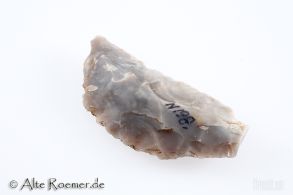 Halbmondförmige Sichel, Neolithikum
Halbmondförmige Sichel, NeolithikumSchnurkeramische Kultur, Dolchzeit, 2400 v. Chr. bis 1700 v. Chr., Fundort: Hessel, Dänemark.
Price: on request Mesolithische Axt
Mesolithische AxtErtebølle-Ellerbek-Kultur, 5100 v. Chr. Bis 4100 v. Chr., Fundort: Rold, Jütland, Dänemark.
Price: on request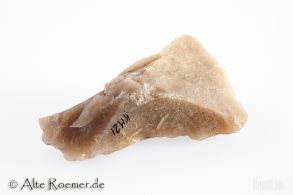 Mesolithische Axt
Mesolithische AxtVermutlich Maglemosekultur, 8000 v. Chr. bis 5000 v.Chr., 74mm lang. Steinzeitliche fein bearbeitete Schneide.
Price: on request Axtklinge aus Flintstein
Axtklinge aus FlintsteinNordeuropäisches Neolithikum, Zeit der Trichterbecher-Kultur. Klinge einer Axt mit scharfen Kanten.
Price: on request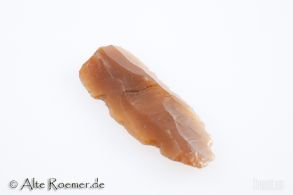 Messerklinge aus Stein, Mesolithikum
Messerklinge aus Stein, Mesolithikum5100 - 4100 v.Chr., Flintwerkzeug der Ertebölle-Ellerbek-Kultur. Die Kultur ist ein wichtiges Bindeglied zwischen Mesolithikum und Neolithikum.
Price: on request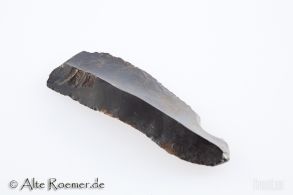 Messerklinge aus Stein, Mesolithikum
Messerklinge aus Stein, Mesolithikum5100 - 4100 v.Chr., Flintwerkzeug der Ertebölle-Ellerbek-Kultur. Die Kultur ist ein wichtiges Bindeglied zwischen Mesolithikum und Neolithikum.
Price: on request Paläolithische Handaxt des Homo Erectus
Paläolithische Handaxt des Homo ErectusAltsteinzeit, um 200.000 v. Chr. Deutliche Spuren grober Werkzeugbearbeitung durch Homo Erectus. Schweres Objekt mit dunkler Patina.
Price: on request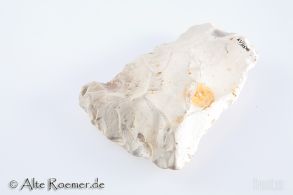 Flachgeschlagenes Scheibenbeil
Flachgeschlagenes ScheibenbeilFrühester Beiltyp der nordeuropäischen Steinzeit, symmetrisch, kantenbearbeitete Ausführung. 5400 v. Chr. bis 4000 v. Chr., Spätmesolithikum, Ertebølle-Ellerbek-Kultur.
Price: on request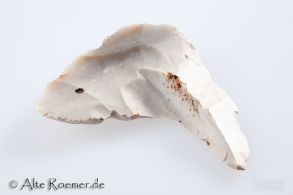 Steinzeitlicher Bohrer
Steinzeitlicher BohrerTypischer steinzeitlicher Bohrer, Spätmesolithikum. Gefunden auf Seeland. Toller weißer Stein, 76mm lang.
Price: on request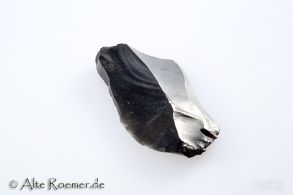 Stichel mit Salzwasserpatina
Stichel mit SalzwasserpatinaSeltenes Werkzeug zur Bearbeitung von Knochen. Fund aus einer wassernahen Siedlung der mesolithischen Maglemosekultur. 8900 v. Chr. bis 6400 v. Chr.
Price: on request Seltene steinzeitliche Klingensichel
Seltene steinzeitliche KlingensichelFrüher Sicheltyp aus dem neolithischen Nordeuropa, vermutlich als Erntesichel verwendet. 4000 v. Chr. bis 2800 v. Chr., Trichterbecher-Kultur.
Price: on request Messer, Homo Neanderthalensis
Messer, Homo NeanderthalensisMesser, mittleres Paläolithikum. Bearbeitung durch Neandertaler, 60000 v. Chr. bis 40000 v. Chr.
Price: on request Messer, Homo Neanderthalensis
Messer, Homo NeanderthalensisMesser, mittleres Paläolithikum. Bearbeitung durch Neandertaler, 60000 v. Chr. bis 40000 v. Chr.
Price: on request Schaber, Homo Neanderthalensis
Schaber, Homo NeanderthalensisSchaber, mittleres Paläolithikum. Bearbeitung durch Neandertaler, 60000 v. Chr. bis 40000 v. Chr.
Price: on request römischer Luxusstilus aus Bein
römischer Luxusstilus aus BeinSpitzer Stift aus Bein zum Beschreiben von Wachstafeln, verziert, sehr gute Erhaltung.
Price: on request Dick-Nacken-Hohl-Beil
Dick-Nacken-Hohl-BeilNeolithisches Beil aus Feuerstein. Dechsel Typ Horneby. 118mm lang. Fundort: Boltinge, Fünen, Dänemark.
Price: on request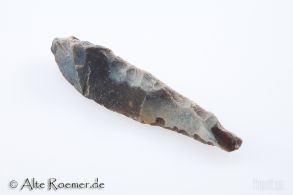 Bohrer aus dem Mesolithikum
Bohrer aus dem MesolithikumBohrer aus Feuerstein, Kongemose Kultur. Fundort Hindsholm, Fünen, Dänemark.
Price: on request Mesolithische Axt
Mesolithische AxtErtebølle-Ellerbek-Kultur. 85mm lang, Salzwasserpatina. Fundort Fyns Hoved, Dänemark. Etwa 5000 v. Chr.
Price: on request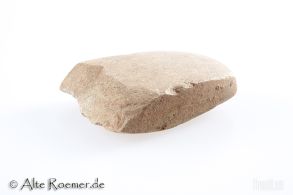 Kleiner Axtkopf
Kleiner AxtkopfNeolithisches kleines Beil. Sehr schöne polierte Oberfläche und feine Bearbeitung. 42mm x 33mm x 12mm. Fundort: Osteuropa.
Price: on request römischer Luxusstilus aus Messing mit Beingriff
römischer Luxusstilus aus Messing mit BeingriffSpitzer Stift aus Messing zum Beschreiben von Wachstafeln. Beingriff mit Messingtülle, sehr gute Erhaltung.
Price: on request römischer Stilus aus Bronze
römischer Stilus aus BronzeSpitzer Stift aus Bronze zum Beschreiben von Wachstafeln. Mehr als 12cm lang, sehr gute Erhaltung. Aus alter deutscher Sammlung.
Price: on request 2 römische Schlossriegel
2 römische SchlossriegelAntike Bolzen für ein Schloss einer Tür oder Truhe. Bronze, 1. bis 4. Jh.n.Chr.
Price: on request Beil / Hammer, Trichterbecherkultur
Beil / Hammer, TrichterbecherkulturUrsprüngliches Beil, das als Schlagstein wiederverwendet wurde. Neolithikum, 4200 bis 2800 v.Chr. Interessantes Zeugnis für den Wert von Feuerstein als Rohstoff. 100mm x 40mm x 40mm.
Price: on request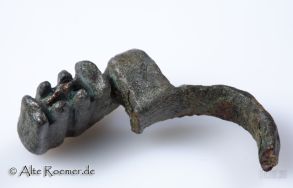 Römischer Bronzeschlüssel
Römischer BronzeschlüsselBart vollständig erhalten mit schöner Patina, ungewöhnliche Form mit sehr kurzem flachem Griff und daran ansetzendem, großem Ring.
Price: on request Roman surgical probe made of silver
Roman surgical probe made of silverThe so-called specillum was standard issue for roman doctors. Similar probes are still in use today. Ancient surgical instruments made of silver are extremely rare.
Price: on request Roman surgical probe made of bronze
Roman surgical probe made of bronzeThe so-called specillum was standard issue for roman doctors. Similar probes are still in use today. Very fine craftsmanship of an ancient surgical instrument.
Price: on request Roman specillum
Roman specillumThe so-called specillum is a surgical probe. It was standard issue for roman doctors. Similar probes are still in use today. 1st to 4th cent. AD.
Price: on request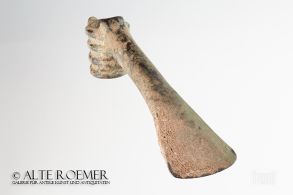 Luristan ceremonial pick
Luristan ceremonial pickThe elaborate decorations are contrary to the actual use as a pick. The object is from the class of pseudo tools common in Iran at the end of the 2nd millenium BC. It probably served a ritualistic purpose.
Price: on request Hand axe from Galilee
Hand axe from GalileeBig paleolithic hand axe. The universal stone age tool could be use as a borer or cutting tool. Around 500,000 to 200,000 BC.
Price: on request Bronze Age axe head
Bronze Age axe headVery well preserved axe head. Late Bronze Age, 10th to 9th cent. BC.
Price: on request Bronze Age axe head
Bronze Age axe headVery well preserved axe head. Late Bronze Age, 10th to 9th cent. BC.
Price: on request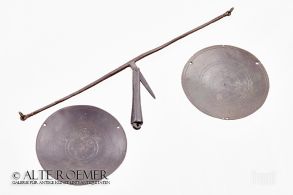 Roman scale balance with pans
Roman scale balance with pansWell preserved small bronze scale. Including two dished pans decorated with incised concentric rings.
Price: on request Roman bronze strainer from "Museum fuer Morgenlandfahrer"
Roman bronze strainer from "Museum fuer Morgenlandfahrer"Large piece in very good condition with nice patina. On display in "Ex Oriente Lux" exhibition, published in the corresponding catalogue.
Price: on request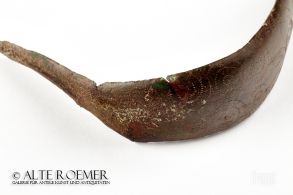
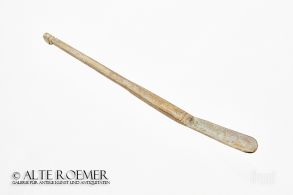 Roman strigilis with workshop mark
Roman strigilis with workshop markExcellently preserved, massive bronze, stable. Workshop mark "N" on the reverse.
Price: on request

